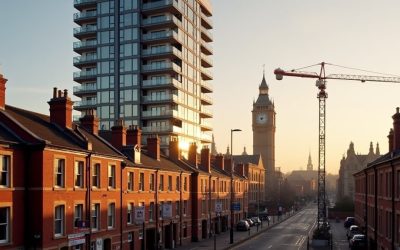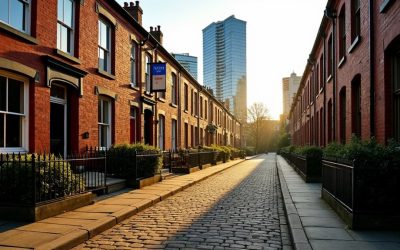Have you ever wondered if solid brick houses are cold? For many people, the idea of living in a home constructed entirely from brick conjures up images of chilly, draughty rooms with no insulation. But is this really true?
Solid brick houses can be cold if they are not properly insulated. Brick is a dense material that can absorb and retain cold temperatures, so without insulation, the cold can seep into the house. However, with proper insulation, solid brick houses can be just as warm and comfortable as any other type of construction.
But that’s not all. Solid brick walls also offer excellent sound insulation. The density of the bricks helps to reduce noise transmission from outside, making your home a peaceful sanctuary away from the hustle and bustle of the outside world.
What are solid brick walls?
Solid brick walls, also known as solid masonry walls, are walls made entirely of bricks or blocks that are bonded together with mortar. These walls do not have a cavity or any voids and are constructed with a single layer of bricks or blocks.
Solid brick walls are often found in older buildings and are known for their durability and structural strength.
However, these walls have limited insulation properties and can be prone to heat loss and cold infiltration. Consequently, they can lead to higher energy bills and overall discomfort during colder months.
To improve the energy efficiency and thermal performance of solid brick walls, various insulation methods, such as internal or external wall insulation, can be applied.
Why do people think solid brick houses are cold?
Solid brick houses are often perceived as being cold due to a combination of factors. One of the main reasons is the poor insulation materials and techniques used in older or poorly constructed brick houses. These houses may not have cavity wall insulation or external wall insulation systems in place, which leads to significant heat loss.
In addition, a lack of central heating or space heaters can contribute to the coldness experienced in solid brick houses. Without a reliable heating system, it can be challenging to maintain a comfortable and warm temperature indoors.
Another significant factor is the high levels of heat loss through windows and doors. In many older brick houses, these areas may not be well-sealed or insulated, allowing cold drafts to enter and warm air to escape.
These factors combined result in a perception that solid brick houses are cold. However, it’s worth noting that advancements in insulation materials and techniques can greatly improve the energy efficiency of a brick house.
Installing cavity wall insulation or external wall insulation systems can help reduce heat loss and make the house more comfortable and energy-efficient. Alongside this, ensuring windows and doors are properly sealed and insulated can also help in preventing cold drafts and maintaining a warmer indoor environment.
Solid Brick Wall Construction
Solid brick wall construction is a traditional and widely used method in building houses. It involves stacking bricks without any gaps or cavities between them, resulting in a strong and durable structure.
While solid brick walls provide excellent strength and stability, they can also present some challenges, particularly when it comes to insulation and temperature regulation.
History of Solid Brick Walls
Solid brick walls have played a significant role in the history of UK construction. Before the 1930s, many houses were built using solid brick wall construction, a technique that involved stacking multiple layers of bricks on top of each other. These walls were known for their solidity and durability.
Solid brick walls were prevalent during this period due to the abundance of brick as a building material. Bricks were widely available and affordable, making them a popular choice for construction. The distinctive characteristics of solid brick walls include their thickness and weight, as well as the lack of a cavity between the inner and outer layers.
These walls offered numerous benefits to homeowners. One key advantage was their thermal properties. Solid brick walls have high thermal mass, meaning they have the ability to absorb and store heat. This property helps maintain a consistent temperature inside the house, keeping it warm in colder months and cool in warmer months.
Another benefit of solid brick walls is their resistance to fire. Brick is a dense material that does not combust easily, offering protection to the occupants of the house. This makes solid brick wall construction a preferred choice for builders concerned with safety.
Although solid brick walls have become less common in modern construction, their historical significance and benefits are still recognized. Houses with solid brick walls often possess a charm and character that is cherished by homeowners.
Structure of Modern Brick Walls
Modern brick walls differ from solid brick walls in terms of construction and insulation. While solid brick walls consist of a single layer of bricks without a cavity, modern brick walls are built with a cavity between the inner and outer layers. This cavity serves as an important component for insulation and moisture control.
The structure of modern brick walls typically includes several layers. The external leaf is the outer layer of bricks that provides protection against the elements. The cavity is a gap between the external leaf and the internal leaf, allowing for the installation of insulation materials. These insulation materials, such as rigid insulation boards or cavity wall insulation, help improve energy efficiency by reducing heat loss.
The internal leaf is the inner layer of bricks or blocks that provides structural support. Internal finishes, such as plaster or drywall, are applied to the internal leaf to provide a smooth and visually appealing surface.
Proper insulation is crucial in modern brick walls to enhance energy efficiency and reduce heating costs. By effectively insulating the cavity, heat loss through the walls is minimized, resulting in lower energy bills. Additionally, insulation helps maintain a comfortable temperature inside the house throughout the year.
In conclusion, the structure of modern brick walls includes an external leaf, cavity, insulation materials, and internal finishes. This construction method and insulation approach contribute to improved energy efficiency and reduced heat loss, making modern brick walls a popular choice for energy-conscious homeowners.
Factors Contributing to Coldness in a Solid Brick House
Despite their many advantages, solid brick houses can sometimes be prone to feeling cold. This can be attributed to several factors, including the density of the brick, the lack of insulation, and the potential for thermal bridging.
Brick, being a dense material, is not as effective in retaining heat as other insulation materials. Without proper insulation, heat loss through the external walls can occur, resulting in cold spots and higher heating bills.
Additionally, solid brick walls can create thermal bridging, which is when heat escapes through gaps or areas of higher conductivity in the wall.
To combat these issues, homeowners may consider options such as solid wall insulation, cavity wall insulation, or external wall insulation systems. These energy-efficient measures can help improve the thermal performance of solid brick houses, making them more comfortable and reducing heating costs.
Poor Insulation Materials and Techniques Used in Building the Walls
Solid brick walls are a common feature in many houses, but unfortunately, they are often constructed using poor insulation materials and techniques. This can have a significant impact on the thermal efficiency of the house and result in increased heat loss.
One of the main issues is the lack of insulation in the walls. Traditional solid brick walls do not typically include any form of insulation, which means that heat can easily escape through the dense material. This results in increased energy bills and a colder indoor environment.
Another problem is the use of permeable materials in the construction of these walls. Brick is a dense material, but it is not a good insulator. Moisture can easily seep through the brickwork, making the walls cold and damp.
In addition, poor insulation techniques like the absence of a continuous vapour barrier and inadequate external wall insulation systems further contribute to heat loss. This allows cold air to penetrate the walls and reduces the overall thermal efficiency of the house.
Overall, solid brick houses can be cold due to poor insulation materials and techniques used in their construction. To improve their thermal efficiency and reduce heat loss, it is essential to consider retrofitting insulation in the form of solid wall insulation or external wall insulation systems, ensuring that the walls are properly sealed and moisture movements are minimized. By addressing these issues, homeowners can enjoy a more comfortable and energy-efficient living environment.
High Levels of Heat Loss Through Windows and Doors
In a solid brick house, windows and doors can be potential sources of high levels of heat loss. Due to their large surface areas and thinner materials compared to the solid brick walls, they can allow heat to escape more easily.
Inefficient windows and doors can contribute to the coldness inside the house, as they can let in drafts and fail to retain heat. This can result in discomfort for the occupants and an increased reliance on heating systems, leading to higher energy bills.
To address these issues, one solution is to upgrade to energy-efficient windows. These windows are designed with multiple layers of glass and low-emissivity coatings, which help to minimize heat transfer. Additionally, adding weatherstripping to doors can create a tight seal, preventing drafts and reducing heat loss.
It is important to note that these improvements not only enhance the insulation of the house but also contribute to energy savings and a more comfortable living environment. By minimizing heat loss through windows and doors, homeowners can effectively combat coldness and reduce their energy bills.
Improving the Thermal Efficiency of a Solid Brick House
A solid brick house, although durable and structurally sound, can often be prone to heat loss and coldness. This can result in discomfort for the inhabitants and higher energy bills due to increased reliance on heating systems.
Fortunately, there are several measures that can be taken to improve the thermal efficiency of a solid brick house. From insulation to ventilation, these solutions aim to minimize heat loss, reduce drafts, and create a more comfortable living environment.
By implementing these strategies, homeowners can not only make their solid brick house more energy-efficient but also save on heating costs and contribute to a more sustainable living environment. So, let’s explore some effective ways to enhance the thermal performance of a solid brick house.
Solutions for External Walls
One effective method is to apply external wall insulation. This involves adding an insulating layer to the outside of the external walls to prevent heat loss and increase thermal resistance. By doing so, not only can the insulation improve the overall energy efficiency of the property, but it can also renew the appearance of the outer walls.
Along with enhancing thermal performance, external wall insulation also offers additional benefits. It helps in weatherproofing the property, making it more resistant to extreme weather conditions. It also provides better sound resistance, reducing the transmission of noise from the outside environment.
Furthermore, external wall insulation can fill cracks, gaps, and imperfections in the brickwork, resulting in a smoother and more uniform finish. It also helps reduce condensation within the walls, which can lead to dampness and mold issues.
In summary, external wall insulation is an effective solution to improve the thermal efficiency of solid brick houses. It not only helps in saving energy and reducing heating costs but also enhances the appearance of the building, improves weatherproofing and sound resistance, fills cracks and gaps, and reduces condensation.
Final Thoughts
In conclusion, solid brick houses can be prone to heat loss and coldness. However, there are several measures that can be taken to improve their thermal efficiency.
From external wall insulation to internal wall insulation, these solutions help minimize heat loss and reduce drafts.
Property owners should consider the type of wall and planning permission when making these improvements. Ultimately, by upgrading traditional masonry walls with energy-efficient solutions, homeowners can effectively combat coldness and reduce their energy bills for a more sustainable living environment.


